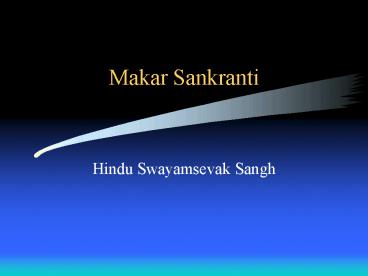Makar Sankranti - PowerPoint PPT Presentation
1 / 15
Title:
Makar Sankranti
Description:
Makar Sankranti Hindu Swayamsevak Sangh Constellation - RASHI 30o 12 x 30o = 360o Constellation - RASHI Crocodile MAKAR Lion Simha Crab Karka Ram Mesh The Zodiac is ... – PowerPoint PPT presentation
Number of Views:5713
Avg rating:3.0/5.0
Title: Makar Sankranti
1
Makar Sankranti
- Hindu Swayamsevak Sangh
2
Constellation - RASHI
12 x 30o 360o
30o
3
Constellation - RASHI
The Zodiac is divided into 12 Rashis
(Constellations)
- Lion
- Simha
- Crab
- Karka
- Ram
- Mesh
- Crocodile
- MAKAR
Crossing of the Sun from one Rashi to the next is
'Sankranti'
4
Makar Sankrant
- Mostly celebrated on 14 January
- (Some traditions celebrate it on 10th Jan)
- Majority festivals are based on Lunar Calendar.
- Makar Sankranti is based on solar calendar
- First of the six utsavs celebrated in Shakha
- Explain why ?
- What does Makar Sankrant mean?
5
Makar Sankranti
- Makar refers to the constellation (rashi)
Capricorn - Sam (good) Kranti (change/ revolution)
- Makar Sankranti is the day the Sun enters Makar
(Capricorn) rashi. - It marks the day the Sun starts moving north and
(uttarayan) the half of the year characterized by
increasing daylight begins.
6
Astronomical Significance
- Days and nights created by spinning
of the earth
- Earth wobbles like a spin top
- For 6 months it tilts towards the Sun (Uttarayan)
and 6 months away from the Sun (Dakshinayan)
7
Importance of 14 January
- Shortest day is on 22 December
- Thereafter days become longer
- But the Sun begins to rise earlier from 14 January
8
New Year Day
- Until 1752, Makar Sankranti used to be on 1st
Jan - 12 days were added to the English calendar in
1752 - Year 1800 was not a leap year so 1 more day was
added - Now Makar Sankranti is on 14th January
- From year 2100 it will be on 15th January
9
Til Gud
- Til (sesame seeds) - Full of goodness
- Gud (jaggery) - Binds the seeds and adds
sweetness - Til and Gud delicacies, if eaten in moderate
quantities, it helps cope up with cold adverse
weather. - Symbolizes family and social bonding.
- Swayamsevaks are like individual seeds
- Aatmiyata / affection, compassion binds them
together. - Shakha offers opportunity to learn a lot and
practice team work.
10
Significance
- Victory of light over darkness
- Indicative of transition
- Change for good
- Start of the year with new ideas, more energy and
vigour - Be thankful for all that you have
- More strength and fun in working together
- Oh, Forgot to mention about fun filled kite
flying event. You, too enjoy it, dont you?
11
Regional Variation
- Makar Sankranti is celebrated all over India with
some regional variations - North India,
- In Punjab, Haryana its called Lohri
- In North East India (Bengal, Assam) - its
called Bhogali Bihu - In Gujarat, Rajasthan Its widely known for
Uttarayan and Kite flying festival - In Maharashtra, its popular among kids for kite
flying and traditional Haldi Kumkum event bring
women neighborhood together. They exchange sweets
and greetings etc. - South India ,
- In Kerala and Tamilnadu - Its called Pongal.
- In Karnataka and Andhra Pradesh Its called
Sankranti - In other parts of India its celebrated as
Makara Sankranti. - Expressing gratitude for harvest adds to the
spirit of celebration.
12
Regional Variation
- In Gujrat, traditionally, UNDHIU (a mix of
vegetables and green beans) and PURI are served
on the festival. Other traditional snacks include
CHIKKI (a sweet peanut / nuts bar) and fruits
like berries and guava. - In Maharashtra, Til Gud recipies are common. The
married ladies in Maharashtra arrange "haldi kum
kum", an auspicious religious get together by way
of which they call upon their friends and
relatives and distribute sweets and gifts. - In Maharashtra, exchange of til-gud is indicative
of overcoming hard feelings and bonding for sweet
relations. - In south India, pongal (rice cooked with milk and
jaggery) is served at homes and temples. - Makara Sankranti is celebrated in Kerala at
Sabarimale where the Makara Jyoti is visible
followed by the Makara Vilakku celebrations. - In Punjab, Haryana, the ritual is done to welcome
newly wed or newly born in front of holy bonfire
where in they offer water soaked rice grains.
Its marked with the spirit of thankful
expression for the harvest.
13
Celebrations Outside India
- In Nepal,
- - Tharu people celebrate it as Maghi
- Other people Maghe Sankranti or Maghe Sakrati
- The Hindu migrated outside India continue to
celebrate this festival on different scales. - In USA, its becoming very popular. In Houston,
TX, 4 to 5 thousand gather for kite flying. - Marathi Mandals continue tradition of Haldi
kumkum
14
Now, its your turn to say
- How would you celebrate it ? Why ?
- What do you like about it ? Why ?
- What did you find inadequately explained ?
- Research for an answer / explanation.
- Share that info. with others.
- More info. on other related traditions.
- Discuss the significance and relevance
15
Tasks to Learn
- Care for your folks, your friends in and outside
of Shakha - Learn to make a kite and manja.
- Learn to cook Pongal, Til Gul, Laddoo, Chikki,
Undhiu, Puri, Dahi-Poha etc. - Share your joys with others.
- Know your friends, their problems, if any.
- How can you be of help to them, in any way ?
- How to overcome hard feelings and start over a
new - bond ?































